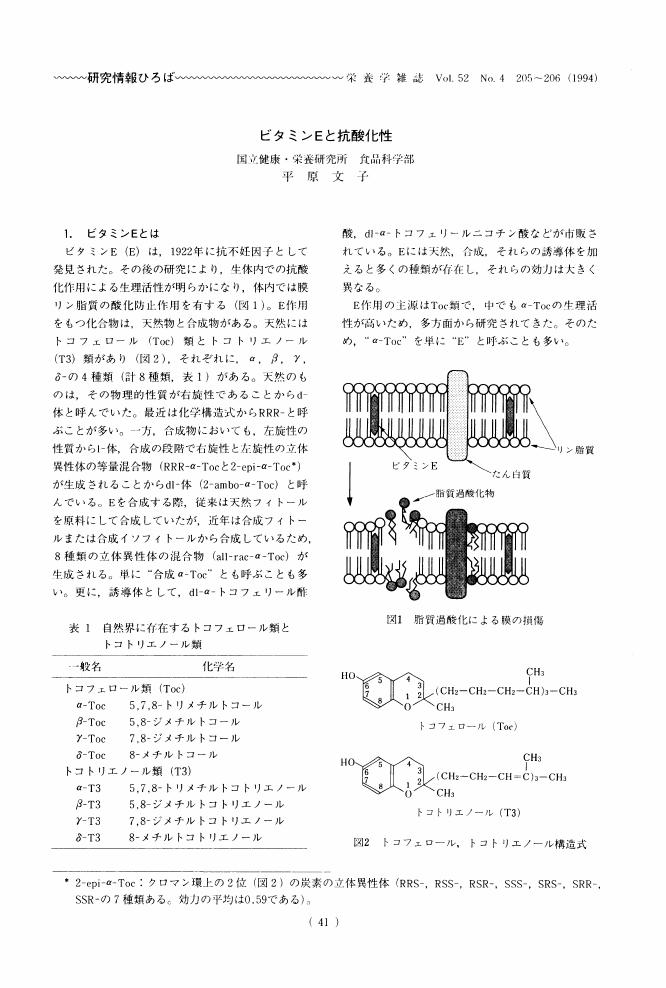5 0 0 0 OA ビタミンEと抗酸化性
- 著者
- 平原 文子
- 出版者
- 特定非営利活動法人 日本栄養改善学会
- 雑誌
- 栄養学雑誌 (ISSN:00215147)
- 巻号頁・発行日
- vol.52, no.4, pp.205-206, 1994 (Released:2010-04-30)
1 0 0 0 健康な保育園児の栄養摂取状況
- 著者
- 平原 文子 小池 佳子 沼野 富子
- 出版者
- 日本ビタミン学会
- 雑誌
- ビタミン (ISSN:0006386X)
- 巻号頁・発行日
- vol.69, no.9, pp.495-501, 1995-09-25
- 被引用文献数
- 1
The nutrition survey of infants at day care center in Tokyo, on 8 healthy boys and 7 girls, aged 13 to 34 months, 74.8 to 91.3cm body height and 9.6 to 14.3 kg body weight was examined by the method based on the national nutrition survey of Japan. The nutritional status was estimated by calculation using the standard tables of food composition in Japan, 4th revised edition and supplementary table of for fatty acids, cholesterol and vitamin E. The mean values of energy, lipids, protein, retinol, thiamine, riboflavin and ascorbic acid in model menu exceeded the recommended dietary allowance(RDA) for infants of the age. The mean intakes of lipid, energy and polyunsaturated fatty acids, protein in boys and girls were almost the same as those in the RDA. The mean intakes of retinol, riboflavin and ascorbic acid exceeded the RDA for infants of the age. A great difference was found in the lipids, thiamine and vitamin E intake between infants, the mean intake value in 2 years old was lower than those of 1 year olds. The daily cholesterol intake was from 147mg to 235mg. The ratio of E/PUFA was higher than 0.6. The ratios of vitamin E intake per 100 kcal energy and per 1 kg in body weight, were from 0.44 to 0.62mg and from 0.30 to 0.60mg, respectively. As a conclusion, the finding of a smaller intake of principal nutrients in 2 years old infants compared with 1 year old infants, involves many nutritional problems. These results suggest that these infants should be required nutritional advice about a well balanced diet and an available selection of proper foods.
- 著者
- 平原 文子 富岡 和久 大谷 八峯 石井 謙二
- 出版者
- 日本ビタミン学会
- 雑誌
- ビタミン (ISSN:0006386X)
- 巻号頁・発行日
- vol.65, no.7, pp.p309-314, 1991-07
- 被引用文献数
- 5
昭和43年〜63年度までの21年間の栄養調査成積より計算した各年次における1日の摂取量とそれに対する各食品類別の寄与率の年次推移について調査した。この調査期間中の1日当たりのE摂取量はほぼ9.4mgで、調査年次の違いによる変動は余り大きなものではなかった。各食品類別の摂取量は年次による違いが見られたが、調査時期の違いが一因であることが推定された。1日のE摂取量に対する各食品類別の寄与率は、各調査年次ともに油脂類が第1位であり、次いで魚介類であった。穀類は昭和47年までは第3位の寄与率を占めていたが、昭和56年に緑黄色野菜類と入れ代わり以降は第4位となった。菓子類の摂取量は昭和47年をピークに年々減少し、代償的に緑黄色野菜類が増えていた。国民一人当たりの平均値で見ると、調査期間中のE摂取量値は成人男子のE目標摂取量を上回っていた。しかし、国民個々人については、他の栄養素の栄養所要量に対する充足分布調査をみると過不足状態のものも少なくないことが指摘されている。E栄養についても不足状態のものも少なくないことが推測され、食生活の改善・栄養指導の必要なものもいることが推定されることから今後検討が急がれる。
1 0 0 0 OA 実験的高コレステロール血症ラットに及ぼすキュウリエソ魚醤の投与効果
- 著者
- 岩本 珠美 平原 文子 金山 功 板倉 弘重
- 出版者
- 県立広島大学
- 雑誌
- 県立広島大学人間文化学部紀要 (ISSN:13467816)
- 巻号頁・発行日
- vol.2, pp.17-25, 2007
本研究では、キュウリエソを原料として麹菌で発酵させて作成した魚醤がラットの脂質代謝に及ぼす効果を検討した。Fisher-344系雄ラット7週齢、1群6匹ずつ4群を設けた。AIN-93G飼料組成を基本とした飼料を与えた群を対照(Cont)群とし、基本飼料+コレステロールを飼料とした群をChol-Cont群、基本飼料+コレステロール+粉末化した魚醤(FSPF)1%を飼料とした群をChol-F1群、基本飼料+コレステロール+FSPF3%を飼料とした群をChol-F3群とした。これらの飼料でラットを4週間飼育し、血清成分、肝臓中の脂質、トコフェロールについて検討した。その結果、体重増加量は、4群間で有意な差はみられなかった。血清脂質についてChol-Cont群とChol-F1群およびChol-F3群を比較検討したところ、血清総コレステロール(TC)値はChol-F1群、Chol-F3群で有意に高値を示し、魚醤の添加効果は認められなかった。血清トリグリセリド(TG)値はChol-F1群では、Chol-Cont群に比べ、有意の低い値であった。また、血清α-Toc値は、Chol-Cont群よりもChol-F1群、Chol-F3群で高い値を示した。さらに、肝臓中の脂質では、TG値はChol-Cont群、Chol-F1群、Chol-F3群の3群間で有意な差は認められなかった。今回の検討では、粉末化した魚醤の摂取により血清TG値の低下が認められたことから、キュウリエソを有効活用できる可能性のあることが示唆された。

